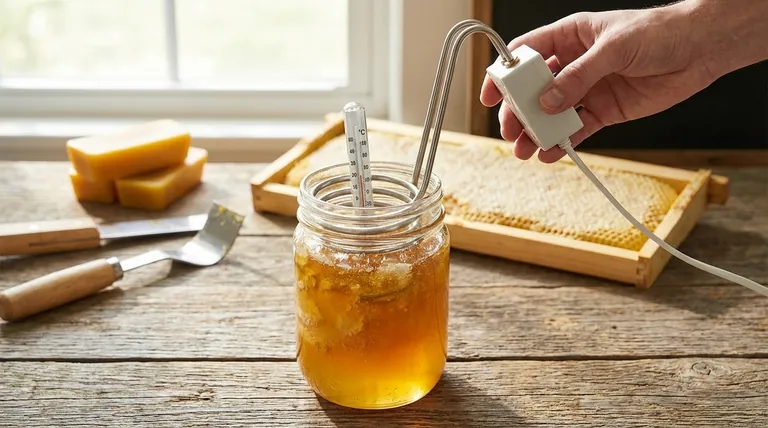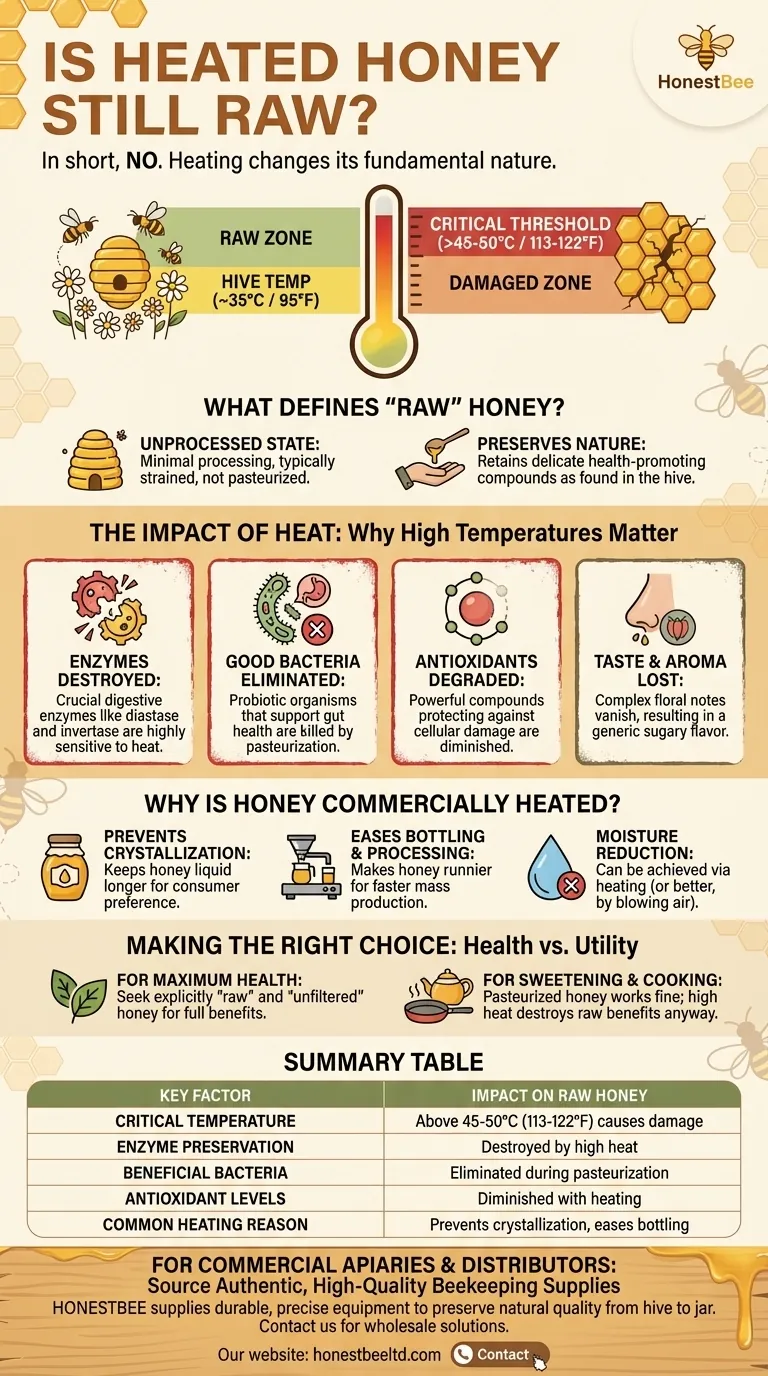In short, no. Heated honey is generally not considered raw once it is warmed above the natural temperatures of a beehive, which is around 35°C (95°F). Most experts agree that heating honey above 45-50°C (113-122°F) begins to destroy its beneficial enzymes and bacteria, fundamentally changing it from its raw state.
The core issue isn't just about a label; it's about preservation. The term "raw" signifies that the honey has not been heated or processed in a way that eliminates the delicate, health-promoting compounds it naturally contains.

What Defines "Raw" Honey?
The definition of "raw" honey revolves around minimal processing. The goal is to keep the honey as close as possible to how it exists inside the honeycomb.
The Core Principle: Unprocessed State
True raw honey is not pasteurized (heated to high temperatures) or filtered excessively. It is typically strained to remove large debris like beeswax or dead bees but retains its fundamental natural composition.
The Critical Temperature Threshold
Heat is the primary factor that disqualifies honey from being considered raw. While gentle warming to hive temperature (around 35°C or 95°F) is acceptable for bottling, exceeding 45-50°C (113-122°F) is the critical point.
At these higher temperatures, the beneficial properties that make raw honey unique begin to break down rapidly.
The Impact of Heat on Honey's Benefits
Heating honey is a common practice in commercial production, but it comes at a significant cost to the honey's nutritional and therapeutic value.
Destruction of Beneficial Enzymes
Raw honey contains natural enzymes, like diastase and invertase, which are introduced by bees. These enzymes are crucial for digestion and other metabolic processes, but they are extremely sensitive to heat and are easily destroyed.
Elimination of Healthy Bacteria
Like other fermented foods, raw honey contains a range of beneficial bacteria and yeasts. These living organisms contribute to a healthy gut microbiome but are quickly killed by the heat of pasteurization.
Degradation of Antioxidants
The powerful antioxidants found in honey, which help protect the body from cellular damage, are also diminished by exposure to high temperatures.
Changes in Taste and Aroma
Heating also causes a deterioration in the honey's delicate flavor and aroma profile. The complex notes derived from specific nectars are lost, resulting in a more generic, sugary taste.
Understanding the Trade-offs: Why Is Honey Heated?
If heating is so destructive, it's fair to ask why commercial producers do it. The reasons are primarily for convenience and marketability, not for the consumer's health.
To Prevent Crystallization
Honey naturally crystallizes over time. Heating it to high temperatures destroys the glucose crystals and keeps the honey in a liquid state for much longer, which many consumers prefer for its appearance and ease of use.
To Ease Processing and Bottling
Warming honey makes it far less viscous (runnier). This allows it to flow through filters and bottling equipment much faster, speeding up mass production.
For Moisture Reduction
In some cases, honey may be heated to reduce its moisture content. However, this can also be achieved without damaging the honey by using methods like blowing air over it for several hours, a technique that preserves its raw qualities.
Making the Right Choice for Your Goal
Ultimately, the right honey depends entirely on your reason for using it.
- If your primary focus is maximum health benefits: Seek out honey that is explicitly labeled "raw" and "unfiltered" to ensure you are getting the full spectrum of enzymes, bacteria, and antioxidants.
- If your primary focus is simple sweetening: A standard, pasteurized honey will function perfectly as a sweetener in tea, on toast, or in recipes, but it will not offer the same therapeutic advantages.
- If you are cooking or baking with it: Adding any honey to high heat will destroy its raw benefits anyway, so using a less expensive pasteurized honey is a practical choice.
Choose your honey with a clear understanding of what you want it to do for you.
Summary Table:
| Key Factor | Impact on Raw Honey |
|---|---|
| Critical Temperature | Above 45-50°C (113-122°F) |
| Enzyme Preservation | Destroyed by high heat |
| Beneficial Bacteria | Eliminated during pasteurization |
| Antioxidant Levels | Diminished with heating |
| Common Heating Reason | Prevents crystallization, eases bottling |
For Commercial Apiaries & Distributors: Source Authentic, High-Quality Beekeeping Supplies
Understanding the delicate nature of raw honey is crucial for producing a superior product. HONESTBEE supplies the durable, precise equipment that commercial apiaries and beekeeping equipment distributors need to handle honey with care, preserving its natural quality from hive to jar.
We provide wholesale-focused solutions to help you maintain the integrity of your honey. Let's discuss your supply needs — contact our team today to learn more about our products and wholesale pricing.
Visual Guide

Related Products
- Professional Thermostatic Conical Honey Melter
- 10L Stainless Steel Electric Honey Press Machine
- Honey Concentrating Vacuum Heating Thickening Machine Dehumidifier for Honey
- 8-Frame Electric Self-Reversing Honey Extractor Spinner for Commercial Honey Extraction Equipment
- Economy Small Scale Honey Dryer Dehumidifier Thickening Machine
People Also Ask
- Why is heating honey sometimes necessary? The Essential Guide to Processing & Quality
- At what temperature does honey flow? Preserve Quality with the Perfect 95°F Sweet Spot
- What is melter honey used for? A Low-Cost Ingredient for Bakers and Brewers
- What equipment is commonly used for heating and processing honey? Essential Tools for Every Beekeeper
- How does the Bee Blanket help maintain honey quality? Preserve Enzymes with Gentle Hive-Mimicking Heat



















